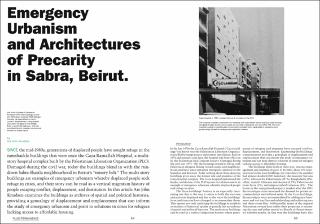| dc.description.abstract | Since the mid-1980s, generations of displaced people have sought refuge in the ramshackle buildings that were once the Gaza-Ramallah Hospital, a multi-story hospital complex built by the Palestinian Liberation Organization (PLO). Damaged during the civil war, today the buildings blend in with the run-down Sabra-Shatila neighbourhood in Beirut’s “misery belt.” The multi-story buildings are examples of emergency urbanism whereby displaced people seek refuge in cities, and their story can be read as a vertical migration history of people escaping conflict, displacement, and destitution. In this article Are John Knudsen examines the buildings as archives of spatial and political histories, providing a genealogy of displacement and emplacement that can inform the study of emergency urbanism and point to solutions in cities for refugees lacking access to affordable housing. | |
